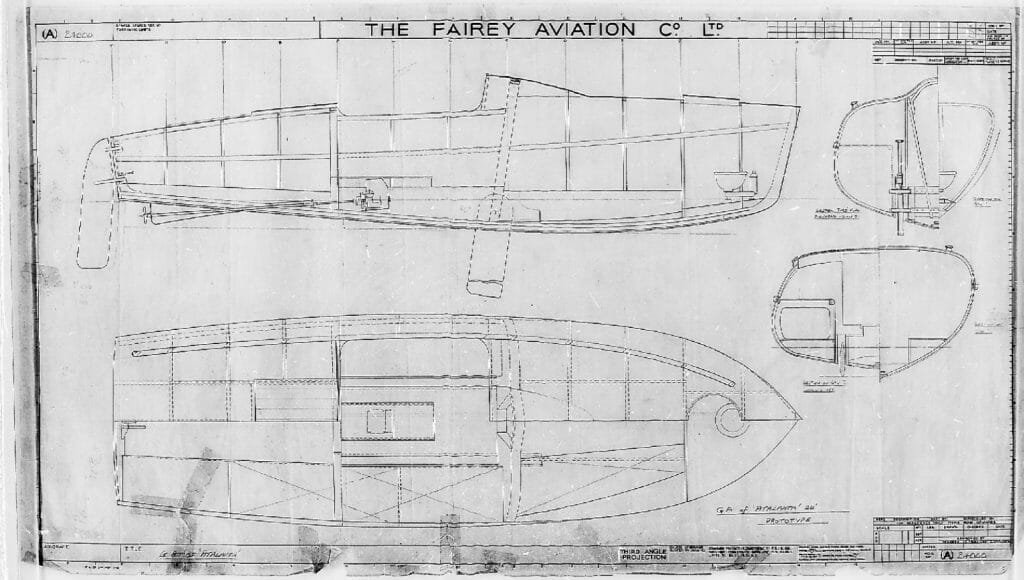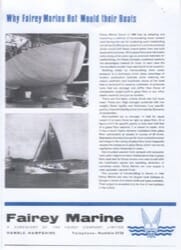After the Second World War Fairey Marine applied the technology developed to make aircraft to boats. Starting with dinghies such as the Firefly, Swordfish, Albacore, and Falcon they started building the Atalanta family in the mid 1950s and then the power boats. All of these sailing craft were ‘hot moulded’ which produced strong and light hulls.
Fairey Marine also applied all of their engineering, production and sailing expertise to how the hulls were fitted out to deliver yachts which are: easily trailed; at home in creeks, estuaries and oceans; a pleasure to sail.
The Hulls – Hot Moulding
In hot moulding Fairey sandwiched three or four thin layers of Agba strips together with glue over a male mould. In each layer the strips run in different directions providing great strength.
A strong wooden mould was made to the internal shape of the hull and placed upside down on a flat metal bed. With the keel, stem and transom in place, layers of veneer strips were applied, Each strip was held in place by three staples: the first the centreline, then the bilge and then the sheerline. The staples were removed as the next layer was applied. The veneers were coated with glue (a thermosetting resin).
Having assembled the layers and glue loosely the whole was covered in a giant rubber bag which was then fixed to the metal base. This was evacuated creating a vacuum and a pressure of nearly 1 atmosphere on the veneers. The whole assembly was then wheeled into a giant ‘pressure cooker’ – an autoclave – to apply further pressure and heat to the layers.
Steam was introduced and maintained at 50psi. After an hour the autoclave was opened and the assembly removed. The remaining staples were withdrawn and the shell was left on the mould overnight. It was then taken off the mould and left to stand to mature for a week before being trimmed and fitted with internal frames for added strength and stiffness. The combination of heat and pressure meant that the glue soaked well into the wood veneers and the hulls have proved remarkably rot-resistant. Fairey placed a Firefly hull in the mud, submerged and exposed by tides every day, for 6 years and it was still intact at the end.
The resin used complied with British Standards Specification 1204 or 1203. It was waterproof, oilproof and resistant to fungal, bacterial and termite attack. The moulding process forced the resin into the wood fibres, and each of the 2.5mm layers of veneer became impregnated, thus preventing water from soaking into the wood or any capillary action.
Agba Veneer – the secret ingredient?
The first hot moulded hulls were in Fireflies and consisted of three layers of 1/16″ resin bonded birchwood ply. This construction was not entirely satisfactory because the outer layers had to be shaved in rounding corners and shaping ends. Such areas were vulnerable to water ingress and Fairey Marine sought the advice of the Forest Products Research Station at Princes Risborough who suggested the use of agba veneer.
Agba, or white tola, is a West African wood from Nigeria and Angola. It is a little lighter in weight than mahogany and the heartwood is durable and resistant to fungi. It contains a natural resin which adds to its rot resistance and it takes up synthetic resin glue and bonds easily. Agba veneer could also be formed easily into the required curves without splitting. Agba was readily available as a veneer 2.5mm thick from John Wright, a timber merchant in the Lea Valley. (Agba veneer is still available today – e.g. from Robbins timber in Bristol – which enables owners to ensure repairs can benefit from the same properties as the original build. (However most repairs today are made using epoxy glues.)
This material used in the hull of the Atalanta has proved remarkably resistant to deterioration. The Fulmar, Atalanta 26 and Titania had 4 layers in the hulls and 3 in the decks.
Mass Production
Each strip in each layer is carefully shaped so that they fit together completely flat on the mould. Fairey Marine applied their engineering skills to mass produce these strips to precision designs rather than shaping each individually on the mould. They were then assembled without further shaping on the moulds.
Veneer strips were cut sufficient for the hulls to be built quickly in batches, each hull given its own factory number. The hulls were then fitted out in turn to make the final yachts. This is why each Atalanta has two different numbers – a Hull number and a Sail Number, the latter allocated as the boats were completed.
This ‘mass production’ process saved an enormous amount of time – up to half the time for a traditional hull. The boats consequently represented great value.
The reason for the choice of Hot Moulded Agba and its properties in comparison with glass fibre resin laminate being introduced at that time was explained in an article published by the Company
Although the hot moulding technique was appreciably cheaper (and quicker) than classical ways of building boats, it still required a high degree of skill in laying up the veneers and was labour intensive compared with glass fibre. It could not compete, costwise, with the growing GRP yacht productions and by the mid-sixties production of the Atalanta ceased. Production of the Motor Boats continued through the 1970s.
It is stronger, in that for equal weight it is many times as rigid as glass fibre. At a figure of 0.7 its specific gravity is less than half that of glass fibre material of non-sandwich construction. It is easier to repair, and it has a much higher abrasive resistance.
Fairey Marine writing about why they chose hot-moulding
Contemporary Fairey Marine Literature
-
Atalanta26, Atalanta31, Titania Why Fairey Hot Mould Their Boats
-
Atalanta26, Atalanta31, Dinghies, faireymarine, Fisherman, Fulmar, Titania Fairey Marine Hot Moulded Hulls
The Atalanta Fit Out- An Engineer's Boat
Fairey Marine had a rich engineering past and it shows through in the details of the Atalanta yachts. Every aspect of the design and build was captured and defined in engineering drawings. AOA members have access to the vast majority of these. A few examples are shown on the right. The hot moulded hull and deck are joined behind the rubbing strake. With a few fore-and-aft stringers they form a light, very strong, homegenous hull. In the centre of this 'cigar' the keel-boxes and angled bulkhead provide the means to spread the loads from the rigging and keels: the mast sits on top of the bulkhead, the keels are hung from metal brackets bolted to the bottom of the bulkhead; and the shrouds are attached by large strap chainplates either side of the bulkhead.

Fairey Marine had a rich engineering past and it shows through in the details of the Atalanta yachts. Every aspect of the design and build was captured and defined in engineering drawings. AOA members have access to the vast majority of these. A few examples are shown on the right. The hot moulded hull and deck are joined behind the rubbing strake. With a few fore-and-aft stringers they form a light, very strong, homegenous hull. In the centre of this 'cigar' the keel-boxes and angled bulkhead provide the means to spread the loads from the rigging and keels: the mast sits on top of the bulkhead, the keels are hung from metal brackets bolted to the bottom of the bulkhead; and the shrouds are attached by large strap chainplates either side of the bulkhead.



